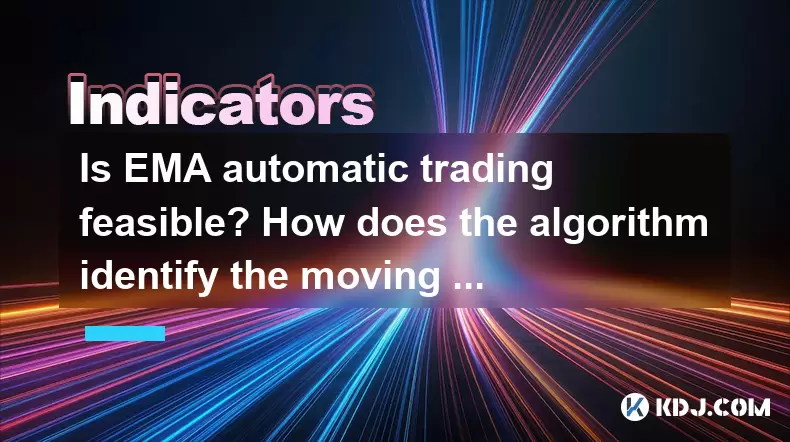-
 bitcoin
bitcoin $112195.049338 USD
2.42% -
 ethereum
ethereum $4124.915858 USD
2.81% -
 tether
tether $1.000570 USD
0.02% -
 xrp
xrp $2.861568 USD
2.25% -
 bnb
bnb $1000.346670 USD
3.04% -
 solana
solana $209.070819 USD
3.38% -
 usd-coin
usd-coin $0.999870 USD
0.02% -
 dogecoin
dogecoin $0.235379 USD
2.65% -
 tron
tron $0.335681 USD
-0.20% -
 cardano
cardano $0.803501 USD
3.38% -
 hyperliquid
hyperliquid $47.120881 USD
3.56% -
 chainlink
chainlink $21.501300 USD
3.44% -
 ethena-usde
ethena-usde $1.000571 USD
0.02% -
 avalanche
avalanche $29.793378 USD
3.62% -
 stellar
stellar $0.366964 USD
2.42%
Is EMA automatic trading feasible? How does the algorithm identify the moving average signal?
EMA automatic trading is feasible and widely used in crypto, with algorithms identifying signals through EMA crossovers and divergence for timely trades.
May 21, 2025 at 02:22 pm

Is EMA Automatic Trading Feasible? How Does the Algorithm Identify the Moving Average Signal?
Automatic trading using the Exponential Moving Average (EMA) is indeed feasible and widely used within the cryptocurrency trading community. The EMA is a type of moving average that places a greater weight on more recent data points, making it more responsive to new information than a simple moving average. This article will delve into the feasibility of EMA automatic trading and how algorithms identify moving average signals, providing a comprehensive understanding of these concepts within the cryptocurrency circle.
Understanding EMA in Cryptocurrency Trading
The Exponential Moving Average (EMA) is a crucial tool in technical analysis, especially in the fast-paced world of cryptocurrency trading. Unlike the Simple Moving Average (SMA), the EMA gives more weight to recent prices, which can help traders identify trends more quickly. In the context of automatic trading, the EMA can be used to generate buy and sell signals based on the crossover of different EMA periods.
EMA Calculation: The EMA is calculated using the formula: EMA_today = (Price_today k) + (EMA_yesterday (1 - k)), where k is the smoothing factor calculated as 2 / (n + 1), and n is the number of periods.
EMA in Cryptocurrency: Cryptocurrencies, known for their volatility, benefit from the EMA's ability to react swiftly to price changes. Traders often use short-term EMAs (e.g., 9-day or 12-day) alongside longer-term EMAs (e.g., 26-day or 50-day) to identify potential entry and exit points.
Feasibility of EMA Automatic Trading
EMA automatic trading is not only feasible but also widely adopted by both retail and institutional traders in the cryptocurrency market. The automation of trading strategies based on EMA signals allows for consistent execution of trades without the emotional biases that human traders might experience.
Algorithmic Execution: Automated trading systems can execute trades based on pre-defined rules derived from EMA crossovers. For instance, a common strategy might involve buying when a shorter-term EMA crosses above a longer-term EMA and selling when the opposite occurs.
Backtesting and Optimization: Before deploying an EMA-based automatic trading strategy, traders typically backtest it using historical data to assess its performance. This process helps in optimizing the parameters of the EMA periods to maximize profitability and minimize risk.
How Algorithms Identify Moving Average Signals
Algorithms used in automatic trading systems identify moving average signals by continuously monitoring the price data and calculating the EMA values in real-time. The identification of signals is based on the interaction between different EMAs, particularly through crossovers and divergences.
EMA Crossovers: A common signal used in automatic trading is the crossover between a short-term EMA and a long-term EMA. When the short-term EMA crosses above the long-term EMA, it is considered a bullish signal, indicating a potential buying opportunity. Conversely, when the short-term EMA crosses below the long-term EMA, it is seen as a bearish signal, suggesting a potential selling opportunity.
Divergence: Algorithms also look for divergence between the price and the EMA. If the price is moving in the opposite direction of the EMA, it could indicate a potential reversal, prompting the algorithm to adjust its trading strategy accordingly.
Implementing EMA Automatic Trading
To implement an EMA automatic trading strategy, traders need to follow a series of steps to set up their trading system. Here's how to do it:
Choose a Trading Platform: Select a trading platform that supports automated trading and has the necessary tools for implementing EMA strategies. Popular platforms among cryptocurrency traders include MetaTrader 4 (MT4), TradingView, and specialized cryptocurrency trading bots like 3Commas.
Set Up the EMA Indicators: Configure the platform to display the desired EMA periods. For instance, you might set up a 9-day EMA and a 26-day EMA to monitor short-term and long-term trends.
Define Trading Rules: Establish clear rules for when to buy and sell based on EMA crossovers. For example, you might decide to buy when the 9-day EMA crosses above the 26-day EMA and sell when the 9-day EMA crosses below the 26-day EMA.
Backtest the Strategy: Use historical data to backtest the EMA strategy. This step is crucial for understanding how the strategy would have performed in the past and for making necessary adjustments.
Implement and Monitor: Once the strategy is set up and backtested, implement it in a live trading environment. Continuously monitor its performance and make adjustments as needed based on real-time market conditions.
Advantages and Challenges of EMA Automatic Trading
EMA automatic trading offers several advantages, but it also comes with its own set of challenges. Understanding these can help traders make informed decisions about whether to adopt this approach.
Advantages:
- Speed and Efficiency: Automated systems can execute trades much faster than humans, capitalizing on opportunities as soon as they arise.
- Consistency: Automation removes emotional decision-making, leading to more consistent trading based on predefined rules.
- 24/7 Trading: Cryptocurrency markets operate around the clock, and automated systems can trade continuously without the need for human intervention.
Challenges:
- Technical Complexity: Setting up and maintaining an automated trading system requires a good understanding of both trading strategies and the technology involved.
- Overfitting: There is a risk of overfitting the strategy to historical data, which may not perform well in future market conditions.
- Market Volatility: The high volatility of cryptocurrency markets can lead to false signals, necessitating robust risk management strategies.
Frequently Asked Questions
Q1: Can EMA automatic trading be profitable in all market conditions?A1: While EMA automatic trading can be profitable, its success largely depends on market conditions. In trending markets, EMA strategies tend to perform well, but they may struggle in sideways or choppy markets where false signals are more common. Traders need to adapt their strategies and risk management techniques to different market environments.
Q2: How do I choose the right EMA periods for my trading strategy?A2: The choice of EMA periods depends on your trading style and the time frame you are trading on. Shorter periods like 9-day or 12-day EMAs are suitable for short-term trading, while longer periods like 26-day or 50-day EMAs are better for longer-term trends. It's important to backtest different combinations to find what works best for your specific goals and market conditions.
Q3: Are there any risks associated with relying solely on EMA signals for trading?A3: Yes, relying solely on EMA signals can be risky. While EMAs can help identify trends, they are not infallible and can generate false signals, especially in volatile markets. It's advisable to use EMA signals in conjunction with other technical indicators and fundamental analysis to improve the accuracy of your trading decisions.
Q4: How can I mitigate the risks of EMA automatic trading?A4: To mitigate the risks of EMA automatic trading, consider the following strategies:
- Diversification: Spread your investments across different cryptocurrencies to reduce the impact of any single asset's performance.
- Stop-Loss Orders: Use stop-loss orders to limit potential losses from any single trade.
- Regular Monitoring: Continuously monitor and adjust your strategy based on market conditions and performance metrics.
- Risk Management: Implement robust risk management techniques, such as position sizing and portfolio allocation, to manage overall exposure.
Disclaimer:info@kdj.com
The information provided is not trading advice. kdj.com does not assume any responsibility for any investments made based on the information provided in this article. Cryptocurrencies are highly volatile and it is highly recommended that you invest with caution after thorough research!
If you believe that the content used on this website infringes your copyright, please contact us immediately (info@kdj.com) and we will delete it promptly.
- Bitcoin, Ethereum, and Correction Concerns: Navigating the Crypto Seas
- 2025-09-30 08:25:12
- ATH Crypto's $344M DePIN Treasury: Aethir's Bold Plan and Market Impact
- 2025-09-30 08:45:14
- XRP, Institutions, and ETF Filings: A New Era for Crypto?
- 2025-09-30 08:45:14
- Crypto Presales: Unveiling Growth Opportunities and the Quest for 100x Returns
- 2025-09-30 08:50:01
- China's Yuan Stablecoin: A Play to Challenge the Dollar's Digital Dominance?
- 2025-09-30 08:50:01
- Crypto Coins with 100x Potential: Navigating the Presale Opportunity Landscape
- 2025-09-30 08:50:01
Related knowledge

What is a tower bottom candlestick pattern? Does it have a high success rate?
Sep 22,2025 at 07:18am
Tower Bottom Candlestick Pattern Explained1. The tower bottom candlestick pattern is a reversal formation that typically appears at the end of a downt...

What is a black hole pattern in the MACD indicator? Is it a cause for concern?
Sep 21,2025 at 06:54pm
Bitcoin's Role in Decentralized Finance1. Bitcoin remains the cornerstone of decentralized finance, serving as a benchmark for value and security acro...

How can I use the psychological line (PSY) to determine market sentiment?
Sep 17,2025 at 02:19pm
Understanding the Psychological Line (PSY) in Cryptocurrency TradingThe Psychological Line, commonly referred to as PSY, is a momentum oscillator used...

How can I determine if a double top pattern has officially formed?
Sep 21,2025 at 03:18am
Understanding the Structure of a Double Top Pattern1. A double top pattern consists of two distinct peaks that reach approximately the same price leve...

What is the Golden Valley pattern on the moving average? Is it better than the Silver Valley pattern?
Sep 21,2025 at 02:54pm
Understanding the Golden Valley Pattern in Moving Averages1. The Golden Valley pattern is a technical formation observed in cryptocurrency price chart...

What does a death cross of the RSI in the strong zone (above 50) mean?
Sep 17,2025 at 10:54pm
Understanding the Death Cross in RSI Context1. The term 'death cross' is traditionally associated with moving averages, where a short-term average cro...

What is a tower bottom candlestick pattern? Does it have a high success rate?
Sep 22,2025 at 07:18am
Tower Bottom Candlestick Pattern Explained1. The tower bottom candlestick pattern is a reversal formation that typically appears at the end of a downt...

What is a black hole pattern in the MACD indicator? Is it a cause for concern?
Sep 21,2025 at 06:54pm
Bitcoin's Role in Decentralized Finance1. Bitcoin remains the cornerstone of decentralized finance, serving as a benchmark for value and security acro...

How can I use the psychological line (PSY) to determine market sentiment?
Sep 17,2025 at 02:19pm
Understanding the Psychological Line (PSY) in Cryptocurrency TradingThe Psychological Line, commonly referred to as PSY, is a momentum oscillator used...

How can I determine if a double top pattern has officially formed?
Sep 21,2025 at 03:18am
Understanding the Structure of a Double Top Pattern1. A double top pattern consists of two distinct peaks that reach approximately the same price leve...

What is the Golden Valley pattern on the moving average? Is it better than the Silver Valley pattern?
Sep 21,2025 at 02:54pm
Understanding the Golden Valley Pattern in Moving Averages1. The Golden Valley pattern is a technical formation observed in cryptocurrency price chart...

What does a death cross of the RSI in the strong zone (above 50) mean?
Sep 17,2025 at 10:54pm
Understanding the Death Cross in RSI Context1. The term 'death cross' is traditionally associated with moving averages, where a short-term average cro...
See all articles


























![[Pycoin] PI Coin -Shocking Listance of Pycoin?! 'Rebellion' This time ... Pay attention to #paikoin [Pycoin] PI Coin -Shocking Listance of Pycoin?! 'Rebellion' This time ... Pay attention to #paikoin](/uploads/2025/09/29/cryptocurrencies-news/videos/pycoin-pi-coin-shocking-listance-pycoin-rebellion-time-pay-attention-paikoin/68da82f23cec1_image_500_375.webp)















































